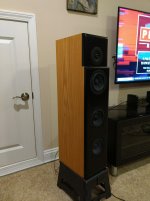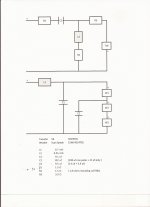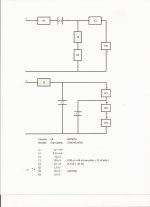This project is long overdue. I started it in 2017 but a house move from Charlotte NC to Myrtle Beach SC intervened. I finally set out to finish it this fall.
It is a 2.5 way tower with three identical Scan Speak 15 cm woofers and an SB29RDC ring radiator. The two bottom woofers roll off around 300 Hz while only the top driver continues to the crossover point, currently at 3.0 KHz.
The woofer is the Special edition Scan Speak Discovery 15W/4524T02. I know some in these pages discouraged others who intended to experiment with this driver. With Troels Gravesen’s success with the Discovery line, I wanted to see how a 15W Discovery with an improved low distortion motor would do.
The design tools were CLIO Pocket for Measurements and LSP Cad for crossover and enclosure design. The crossover configuration is a second order LR. The woofer section 2.5 way is derived by a less common series connection with a large bypass capacitor across the bottom 2 drivers. There is a certain elegance to this design since the voltage summation across all three drivers always equals the value of the input coming from the crossover. It does not however, compensate for baffle step the way a parallel arrangement can. I suspect that some successful commercial designs use this concept.
I was surprised by the high frequency performance of the Discovery woofers and the resulting simplicity of the crossover. They seem far smoother than the smaller 12W version, but not quite a 10F. I expected more complexity to deal with HF irregularities but some additional planned components zeroed themselves out in optimization. The low inductance motor definitely helps also. It is still a work in progress but the attached schematic is where the design stands at this moment.
It is a 2.5 way tower with three identical Scan Speak 15 cm woofers and an SB29RDC ring radiator. The two bottom woofers roll off around 300 Hz while only the top driver continues to the crossover point, currently at 3.0 KHz.
The woofer is the Special edition Scan Speak Discovery 15W/4524T02. I know some in these pages discouraged others who intended to experiment with this driver. With Troels Gravesen’s success with the Discovery line, I wanted to see how a 15W Discovery with an improved low distortion motor would do.
The design tools were CLIO Pocket for Measurements and LSP Cad for crossover and enclosure design. The crossover configuration is a second order LR. The woofer section 2.5 way is derived by a less common series connection with a large bypass capacitor across the bottom 2 drivers. There is a certain elegance to this design since the voltage summation across all three drivers always equals the value of the input coming from the crossover. It does not however, compensate for baffle step the way a parallel arrangement can. I suspect that some successful commercial designs use this concept.
I was surprised by the high frequency performance of the Discovery woofers and the resulting simplicity of the crossover. They seem far smoother than the smaller 12W version, but not quite a 10F. I expected more complexity to deal with HF irregularities but some additional planned components zeroed themselves out in optimization. The low inductance motor definitely helps also. It is still a work in progress but the attached schematic is where the design stands at this moment.
Attachments
Attached is the latest Revision of the crossover.
I am very impressed with the Scan 15W/4524T. The response is very smooth and flat. I was prepared for a complex crossover with RLC filters and RC bypasses on the main inductor. The more I worked with it, the extra components just faded out of the picture. This woofer just does not need much to work in a nearly ideal LR2. It sounds clean right up to 3 KHz. The first slight deviation from true LR in the stop band occurs at 6-7 KHz at about -15 dB from reference level. The .5 way design with the bypass cap around the lower woofers just plain works. Too bad this driver is a limited edition. I think it is a cut above the other drivers in the discovery line and a serious competitor to more expensive Scan-speaks.
I am not too sure If I will stay with the SB29RDC. Response at the top is not as smooth as I expected and I can hear and measure a slight difference between channels. I am still trying to determine how much of the response anomalies are diffraction or in the driver. It sounds very open but just a bit unrefined. The dip at 3K and bloom around 800-2000 Hz is a bit more pronounced than the factory measurements indicate. I may try my old Scan 9500 or the Scan version of the XT25. Another possibility is the Satori TW29RN which seems to have a better controlled low end than the SB29 or regular TW29R. I don't know if the new SB29RDAC with the new front plate is any improvement over the older version. I would like to hear from someone who has tried it.
I am very impressed with the Scan 15W/4524T. The response is very smooth and flat. I was prepared for a complex crossover with RLC filters and RC bypasses on the main inductor. The more I worked with it, the extra components just faded out of the picture. This woofer just does not need much to work in a nearly ideal LR2. It sounds clean right up to 3 KHz. The first slight deviation from true LR in the stop band occurs at 6-7 KHz at about -15 dB from reference level. The .5 way design with the bypass cap around the lower woofers just plain works. Too bad this driver is a limited edition. I think it is a cut above the other drivers in the discovery line and a serious competitor to more expensive Scan-speaks.
I am not too sure If I will stay with the SB29RDC. Response at the top is not as smooth as I expected and I can hear and measure a slight difference between channels. I am still trying to determine how much of the response anomalies are diffraction or in the driver. It sounds very open but just a bit unrefined. The dip at 3K and bloom around 800-2000 Hz is a bit more pronounced than the factory measurements indicate. I may try my old Scan 9500 or the Scan version of the XT25. Another possibility is the Satori TW29RN which seems to have a better controlled low end than the SB29 or regular TW29R. I don't know if the new SB29RDAC with the new front plate is any improvement over the older version. I would like to hear from someone who has tried it.
Attachments
Hi Fernando, I have been interested in doing a 2.5 way build with series 4 ohm woofers. There doesn't seem to be too much info regarding this type of crossover, but some searches have led me to a few of the threads you have started on the topic. I understand this type of crossover doesn't help with bsc because of the increased impedance at low frequencies. But what if the (2) 0.5 woofers were wired in parallel to each other? Wouldn't we gain 6db for adding 2x more radiating surface but only suffer a 1.5db hit for adding 2 ohms to the overall impedance? Resulting in 4.5db of bsc. It's not full bsc but should help reduce throwing away sensitivity with electrical bsc
The use of the series connection on the woofers that one gets no extra gain from the extra woofers, only (dramatically) less excursion. A typical 2.5 way with an inductor gives gain (often used to fight bafflestep). And the higher impedance at lower frequencies means that your amp will have to work less hard (but will put out less power).
This sort of falls out of the typical x.5 way systems range so info on the way iy is done may be harder to find.
Personally i prefer this approach in most cases.
dave
This sort of falls out of the typical x.5 way systems range so info on the way iy is done may be harder to find.
Personally i prefer this approach in most cases.
dave
Interesting and I find this timely. Is there not a modest increase from the .5 woofer (while not at BSC level)? For giggles, I plugged this in to a 2.5 that I'm working on and while there was a decrease modeled from using an inductor, there was a modest increase overall in output.
I'd like to learn more on this if there are links/discussions around covering this
I'd like to learn more on this if there are links/discussions around covering this
I like the reasoning, although with the top woofer seeing 4/6 of the drive Voltage it would go down 3.5dB.what if the (2) 0.5 woofers were wired in parallel to each other? Wouldn't we gain 6db for adding 2x more radiating surface but only suffer a 1.5db hit for adding 2 ohms to the overall impedance?
@Planet10 - I know this falls out of the typical category. Very few people are talking about series 2.5 ways much less building them, like Fernando here. I was hoping to get his insight as well as any other knowledgeable people on here the subject. I've tried playing around with this in Xsim, but I'm not sure if Xsim is even capable of properly modeling it.
@AllenB - Wouldn't it only be 3.5db down below where the other woofers roll in? This might be another added benefit by further reducing the excursion of the woofer that has to play the upper midrange
FWIW, I have little experience in building speakers. I've been interested in it for about a year and half now but have been reluctant to jump into any projects because I've done enough reading to understand the importance of measurement and design. I built some small bookshelves, a few months ago, using salvaged drivers and parts with measurements taken with my AVR setup mic. They sound, ok. Good enough to be surrounds in my 5.1 setup. I have recently acquired a Dayton UMM-6 and a Dayton DATS V3 though. So now I'm looking to build something a little more serious
@AllenB - Wouldn't it only be 3.5db down below where the other woofers roll in? This might be another added benefit by further reducing the excursion of the woofer that has to play the upper midrange
FWIW, I have little experience in building speakers. I've been interested in it for about a year and half now but have been reluctant to jump into any projects because I've done enough reading to understand the importance of measurement and design. I built some small bookshelves, a few months ago, using salvaged drivers and parts with measurements taken with my AVR setup mic. They sound, ok. Good enough to be surrounds in my 5.1 setup. I have recently acquired a Dayton UMM-6 and a Dayton DATS V3 though. So now I'm looking to build something a little more serious
I have a couple documents that might help. The examples are FR drivers, but the top one can always have a tweeter added.
2 drivers: http://www.planet10-hifi.com/downloads/Dual-Driver-Wiring.pdf
4 drivers: http://www.planet10-hifi.com/downloads/Quad-Driver-Wiring.pdf
I never thot of using three, but it should work just fine. And that implies i am missing a possible wiring in my Quad document. 4 in series, with 3 of them shunted by a cap.
I’ll have to think about ways you could get a bit of gain at the bottom. I usually have no issues with BS. And remeber that every correction of the on-axis response raises the total power response above ideal by the same amount.
dave
2 drivers: http://www.planet10-hifi.com/downloads/Dual-Driver-Wiring.pdf
4 drivers: http://www.planet10-hifi.com/downloads/Quad-Driver-Wiring.pdf
I never thot of using three, but it should work just fine. And that implies i am missing a possible wiring in my Quad document. 4 in series, with 3 of them shunted by a cap.
I’ll have to think about ways you could get a bit of gain at the bottom. I usually have no issues with BS. And remeber that every correction of the on-axis response raises the total power response above ideal by the same amount.
dave
Yes. Baffle step is a funny thing though (in a room). Ideally (anechoically) it should be 6dB.Wouldn't it only be 3.5db down below where the other woofers roll in? This might be another added benefit by further reducing the excursion of the woofer that has to play the upper midrange
- Status
- This old topic is closed. If you want to reopen this topic, contact a moderator using the "Report Post" button.
- Home
- Loudspeakers
- Multi-Way
- Three Woofer 2.5 Way Tower


